You are an administrator in an organization. You share files in chats with other users.
The users report that they are unable to access the files. Users see an error message as shown in the image: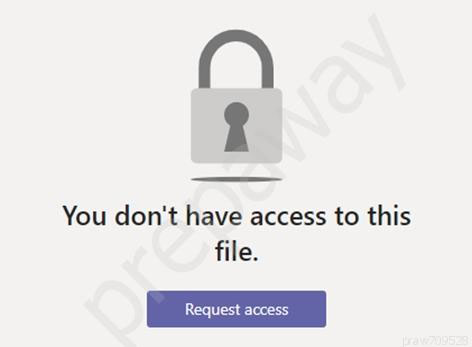
You need to resolve the issue by updating the OneDrive for Business settings for the users. You navigate to the settings page for the Team's SharePoint site collection.
What should you do?
Answer:
C
Reference:
https://docs.microsoft.com/en-us/sharepoint/troubleshoot/administration/access-denied-or-need-permission-error-sharepoint-online-or-onedrive-for-business
Introductory Info
Case study -
This is a case study. Case studies are not timed separately. You can use as much exam time as you would like to complete each case. However, there may be additional case studies and sections on this exam. You must manage your time to ensure that you are able to complete all questions included on this exam in the time provided.
To answer the questions included in a case study, you will need to reference information that is provided in the case study. Case studies might contain exhibits and other resources that provide more information about the scenario that is described in the case study. Each question is independent of the other questions in this case study.
At the end of this case study, a review screen will appear. This screen allows you to review your answers and to make changes before you move to the next section of the exam. After you begin a new section, you cannot return to this section.
To start the case study -
To display the first question in this case study, click the Next button. Use the buttons in the left pane to explore the content of the case study before you answer the questions. Clicking these buttons displays information such as business requirements, existing environment, and problem statements. When you are ready to answer a question, click the Question button to return to the question.
Background -
Contoso, Ltd. is a telecommunications company that has offices in Bulgaria, Italy, Canada, and the United States. The company has 5,000 employees. The company has the following departments:
IT
Sales
Human resources (HR)
Research and development (R&D)
Technical support
Legal
The company does a lot of business with the following partner companies. Contoso employees are not able to communicate with these partners by using Microsoft
Teams.
Microsoft.com
PartnerCompanyLTD.com
The company currently uses Skype for Business (SfB) as a collaboration tool. The company wants to migrate to Microsoft Teams. Contoso is beginning a pilot project as part of a Microsoft Teams upgrade. You determine that some offices do not have calling plan licenses.
Current environment -
Active directory -
The network contains an on-premises Active Directory domain. All user accounts are assigned to departmental organizational units (OUs).
Network environment -
All traffic is routed through a VPN solution.
Average network bandwidth on Wi-Fi is 3.2 mbps.
Microsoft 365 -
You assign all employees a Microsoft Office 365 E5 license. You enable the following services for all users:
Microsoft Exchange Online
Microsoft SharePoint Online
Microsoft OneDrive for Business
Azure AD dynamic group membership
Azure Active Directory (Azure AD)
Microsoft Teams -
The Microsoft Teams upgrade policy is set to Islands coexistence mode.
Requirements -
Calling -
You must create auto attendants and call queue groups for the sales department and the support department. You must configure the following numbers:
Sales department employees must be able to dial international numbers. Other department employees must be prevented from dialing international numbers.
The secondary number for the sales department must always be displayed whenever a sales department employee makes an outbound call.
Calls to support team members must be distributed in such a way that each agent gets the same number of calls.
Emergency calling -
You must configure the following normalization rules for emergency calls:
Sales department users need to use 4-digit extension calling.
Support department users need to use 5-digit extension calling.
All local calls for Redmond (country code and region code is +1425) should be dialed without having to put the +1425 in front of the number.
Security -
You must implement dynamic group membership and use the department's attribute.
Users must change their password every 60 days.
You must implement a new security policy that has the following requirements:
Only guest users from the approved partner domains must be allowed to connect to collaborate by using Microsoft Teams.
Guest users must be prevented from inviting other guests.
Guest users must be prevented from making private calls.
The sales and the technical support department should be able to dial out using the corresponding number.
Guest users should only be allowed to chat from their own accounts.
Teams channels -
Teams and channels must meet the following compliance requirements:
Each team must expire 365 days after it is created.
All team content must be deleted when the team expires
An administrator must be able to restore deleted team content within 30 days.
Group names must not change once they are created.
Meetings and live events -
You identify the following requirements for meetings and live events:
All meetings facilitated by employees must be hosted on Microsoft Teams.
Guest users must be able to join live events.
Guest users must always wait in a meeting lobby.
Employees must always bypass the meeting lobby when they join meeting by using the Microsoft Teams client.
You must record all live events.
Issues -
User1 -
User1 starts an important meeting by using Microsoft Teams. The call drops unexpectedly. User1 provides you with the following log data after reproducing the issue:
User2 -
Administrators report that User2 can sign in to Teams. Most policies are assigned to User2, but you are not able to assign a phone number to User2. You run the following PowerShell command and review the output:
User3 -
User3 reports an authentication issue while signing in to Teams. You troubleshoot the issue by reviewing the Teams desktop app logs. You identify the following authentication error message:
0xCAA82EE7 The server name could not be resolved.
User4 -
User4 reports that they receive multiple email messages about missed chat conversations.
Sales team -
You create a Team named Test is used by the sales team.
All users report that an error message displays when they view the Files tab in the general channel for the team.
You view the following error in the debug logs:
2021-05-14T14:56:54.001Z Err items-view error:
singleOperationHandler.spFolderItemSet.getItems - File Not Found.
Conditional Access policy -
Users report a variety of issues accessing resources. You run the following PowerShell cmdlets:
$CA = Get-AzureADMSConditionalAccessPolicy `"Identity
$CA.ToJson()
You review the output from the cmdlets:
Teams performance -
After recent network changes, users report the following issues that impact all users:
Messages arrive to recipients after significant delays.
The Teams app loads slowly.
The quality of audio and video during meetings is poor.
Calls drop unexpectedly and it takes a long time to rejoin meetings.
You review the following log entries: Question
HOTSPOT -
Question
HOTSPOT -
You need to troubleshoot the Microsoft Teams performance. To answer select the appropriate options in the answer area.
:
NOTE -
Each correct selection is worth one point.
Hot Area: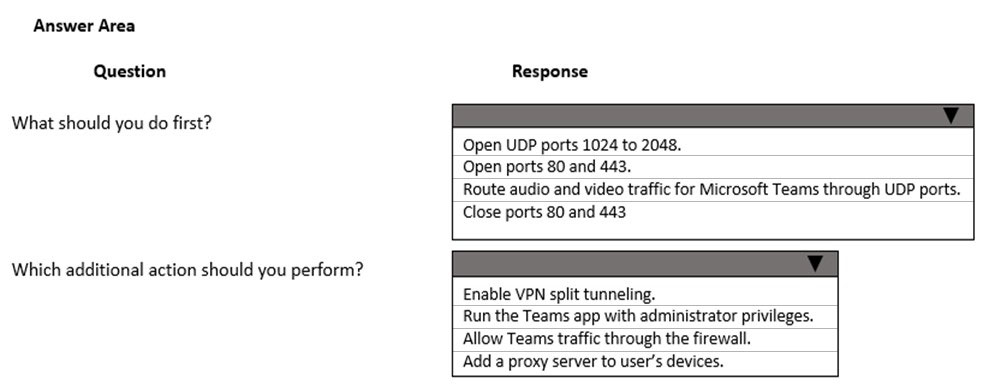
Answer:
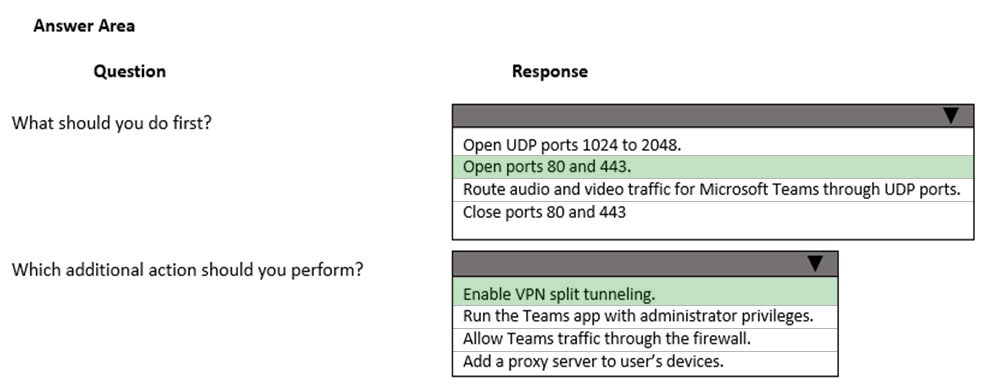
Introductory Info
Case study -
This is a case study. Case studies are not timed separately. You can use as much exam time as you would like to complete each case. However, there may be additional case studies and sections on this exam. You must manage your time to ensure that you are able to complete all questions included on this exam in the time provided.
To answer the questions included in a case study, you will need to reference information that is provided in the case study. Case studies might contain exhibits and other resources that provide more information about the scenario that is described in the case study. Each question is independent of the other questions in this case study.
At the end of this case study, a review screen will appear. This screen allows you to review your answers and to make changes before you move to the next section of the exam. After you begin a new section, you cannot return to this section.
To start the case study -
To display the first question in this case study, click the Next button. Use the buttons in the left pane to explore the content of the case study before you answer the questions. Clicking these buttons displays information such as business requirements, existing environment, and problem statements. When you are ready to answer a question, click the Question button to return to the question.
Background -
Fabrikam, Inc. Ltd. is a pharmaceutical company with offices in the USA, UK, and Australia. The company has the following departments:
IT
Sales
Human resources (HR)
Research and development (R&D)
Technical support
Legal department
You join the company as a Microsoft Teams administrator.
Current environment -
Active Directory -
The network contains an on-premises Active Directory domain. All user accounts are assigned to departmental organizational units (OUs).
Microsoft 365 -
You assign all employees a Microsoft Office 365 E3 license. Fabrikam has recently migrated from Skype for Business server to Microsoft Teams.
Network environment -
The company uses a combination of IPv4 and IPv6 addresses.
Calling -
The company plans to use a Session Border Controller (SBC) connected to Phone System Direct Routing for their telephony solution. The company registers the
SBC domain name, sip.contoso.com, in as tenant domain.
Requirements -
Emergency calling -
You must configure a tenant trusted IP list for emergency address locations.
Security -
Sales interns must not have the ability to share files in one-on-one chats. Teams and channels must meet following compliance requirements:
You must create the following groups for teams and channels: Team Owners, Team Members and Team Visitors.
The Team Visitors group is for internal UserX that does not have access to the Private channels chats, but does have access to SharePoint sites for auditing the files within the private channels.
Channels for the different departments must not inherit permissions from the parent sites. Permissions for each channel must be unique.
ProjectNextGenApp -
The R&D team has a private channel named ProjectNextGenApp. The members of the channel need to collaborate on files with an external user, but they do not want the external user to be able to read and send messages in the channel.
Legal department -
You must ensure that users in the legal department can view the files uploaded by owners within one channel or access SharePoint.
Issues -
CEO -
The company's CEO reports that they do not receive notifications for chat messages in the desktop version of Microsoft Teams.
AdministratorA -
AdministratorA is configuring Direct Routing. The administrator runs following PowerShell command to pair the SBC to the tenant or add the SBC from the Teams admin center.
The following error message displays:
Human resources manager -
The human resources manager is unable to access the files in a Private channel named StaffRecruiters. He gets an error message when they select the Files tab that the Item does not exist or no longer available.
Audit team -
Users who are part of the audit team report that they were unable to access the Files tab of a channel in the team. The following error message displays when they attempt to access files: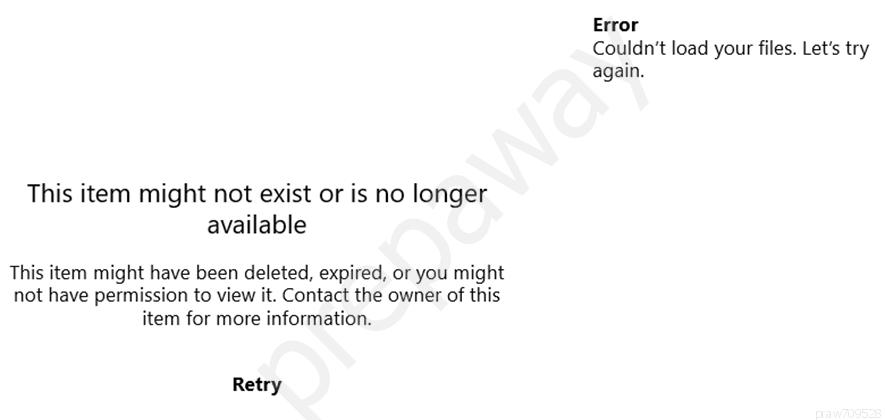
User1 -
User1 reports high CPU usage while using the Teams application and would like to know more on how Teams uses resources.
User2 -
User2 reports that automatic updates for the Teams client are not working.
User3 -
User3 reports that they are not able to download a file that was shared with them in a one-to-one chat within the Files tab. The following error message displays:
"This item might not exist or is no longer available."
User4 -
User4 reports that the following message displays when they navigate to the SharePoint Site for the private channel:
"Access denied"
User5 -
User5 has multiple groups and contacts but none of the groups or users appear in the Teams app. The Contact List Provider for User5 is listed as Unified Contact
Store (UCS).
User6 -
User6 reports that they are not able to download a file that was shared with them in a one-to-one chat within the Files tab and receives the follow error message:
"This item might not exist or is no longer available."
Emergency calling -
Users report that the Teams app does not display an emergency address in the calls section of client settings. No emergency address is listed when placing a call.
You collect Teams debug logs from a user. A representative section of the log is shown below:
Reports -
Users within the company report poor quality when they make Teams calls and dial telephone numbers. You must generate the following reports to troubleshoot the issues:
Report1: Show Public Switched Telephone Network (PSTN) calls for the last 28 days.
Report2: Compare usage and quality across users.
Question
You need to resolve the emergency address issue.
What should you do?
Answer:
C
Reference:
https://docs.microsoft.com/en-us/microsoftteams/configure-dynamic-emergency-calling
Introductory Info
Case study -
This is a case study. Case studies are not timed separately. You can use as much exam time as you would like to complete each case. However, there may be additional case studies and sections on this exam. You must manage your time to ensure that you are able to complete all questions included on this exam in the time provided.
To answer the questions included in a case study, you will need to reference information that is provided in the case study. Case studies might contain exhibits and other resources that provide more information about the scenario that is described in the case study. Each question is independent of the other questions in this case study.
At the end of this case study, a review screen will appear. This screen allows you to review your answers and to make changes before you move to the next section of the exam. After you begin a new section, you cannot return to this section.
To start the case study -
To display the first question in this case study, click the Next button. Use the buttons in the left pane to explore the content of the case study before you answer the questions. Clicking these buttons displays information such as business requirements, existing environment, and problem statements. When you are ready to answer a question, click the Question button to return to the question.
Background -
Contoso, Ltd. is a telecommunications company that has offices in Bulgaria, Italy, Canada, and the United States. The company has 5,000 employees. The company has the following departments:
IT
Sales
Human resources (HR)
Research and development (R&D)
Technical support
Legal
The company does a lot of business with the following partner companies. Contoso employees are not able to communicate with these partners by using Microsoft
Teams.
Microsoft.com
PartnerCompanyLTD.com
The company currently uses Skype for Business (SfB) as a collaboration tool. The company wants to migrate to Microsoft Teams. Contoso is beginning a pilot project as part of a Microsoft Teams upgrade. You determine that some offices do not have calling plan licenses.
Current environment -
Active directory -
The network contains an on-premises Active Directory domain. All user accounts are assigned to departmental organizational units (OUs).
Network environment -
All traffic is routed through a VPN solution.
Average network bandwidth on Wi-Fi is 3.2 mbps.
Microsoft 365 -
You assign all employees a Microsoft Office 365 E5 license. You enable the following services for all users:
Microsoft Exchange Online
Microsoft SharePoint Online
Microsoft OneDrive for Business
Azure AD dynamic group membership
Azure Active Directory (Azure AD)
Microsoft Teams -
The Microsoft Teams upgrade policy is set to Islands coexistence mode.
Requirements -
Calling -
You must create auto attendants and call queue groups for the sales department and the support department. You must configure the following numbers:
Sales department employees must be able to dial international numbers. Other department employees must be prevented from dialing international numbers.
The secondary number for the sales department must always be displayed whenever a sales department employee makes an outbound call.
Calls to support team members must be distributed in such a way that each agent gets the same number of calls.
Emergency calling -
You must configure the following normalization rules for emergency calls:
Sales department users need to use 4-digit extension calling.
Support department users need to use 5-digit extension calling.
All local calls for Redmond (country code and region code is +1425) should be dialed without having to put the +1425 in front of the number.
Security -
You must implement dynamic group membership and use the department's attribute.
Users must change their password every 60 days.
You must implement a new security policy that has the following requirements:
Only guest users from the approved partner domains must be allowed to connect to collaborate by using Microsoft Teams.
Guest users must be prevented from inviting other guests.
Guest users must be prevented from making private calls.
The sales and the technical support department should be able to dial out using the corresponding number.
Guest users should only be allowed to chat from their own accounts.
Teams channels -
Teams and channels must meet the following compliance requirements:
Each team must expire 365 days after it is created.
All team content must be deleted when the team expires
An administrator must be able to restore deleted team content within 30 days.
Group names must not change once they are created.
Meetings and live events -
You identify the following requirements for meetings and live events:
All meetings facilitated by employees must be hosted on Microsoft Teams.
Guest users must be able to join live events.
Guest users must always wait in a meeting lobby.
Employees must always bypass the meeting lobby when they join meeting by using the Microsoft Teams client.
You must record all live events.
Issues -
User1 -
User1 starts an important meeting by using Microsoft Teams. The call drops unexpectedly. User1 provides you with the following log data after reproducing the issue:
User2 -
Administrators report that User2 can sign in to Teams. Most policies are assigned to User2, but you are not able to assign a phone number to User2. You run the following PowerShell command and review the output: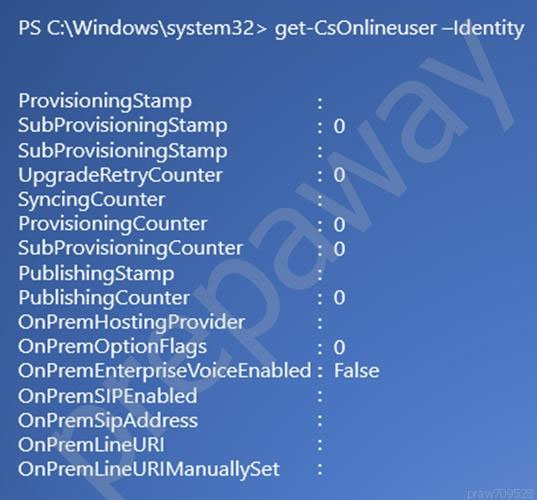
User3 -
User3 reports an authentication issue while signing in to Teams. You troubleshoot the issue by reviewing the Teams desktop app logs. You identify the following authentication error message:
0xCAA82EE7 The server name could not be resolved.
User4 -
User4 reports that they receive multiple email messages about missed chat conversations.
Sales team -
You create a Team named Test is used by the sales team.
All users report that an error message displays when they view the Files tab in the general channel for the team.
You view the following error in the debug logs:
2021-05-14T14:56:54.001Z Err items-view error:
singleOperationHandler.spFolderItemSet.getItems - File Not Found.
Conditional Access policy -
Users report a variety of issues accessing resources. You run the following PowerShell cmdlets:
$CA = Get-AzureADMSConditionalAccessPolicy `"Identity
$CA.ToJson()
You review the output from the cmdlets: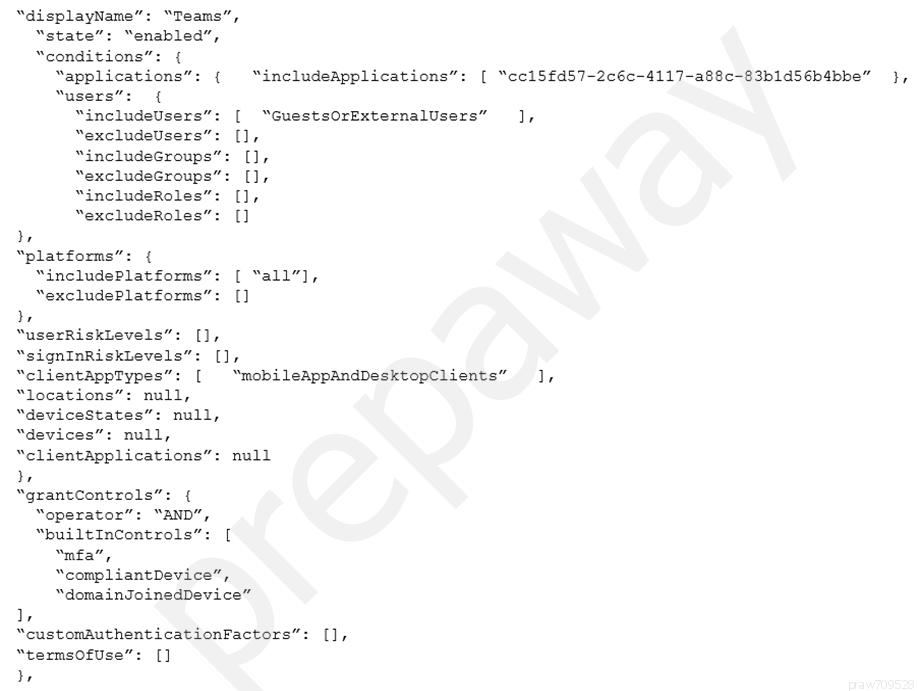
Teams performance -
After recent network changes, users report the following issues that impact all users:
Messages arrive to recipients after significant delays.
The Teams app loads slowly.
The quality of audio and video during meetings is poor.
Calls drop unexpectedly and it takes a long time to rejoin meetings.
You review the following log entries: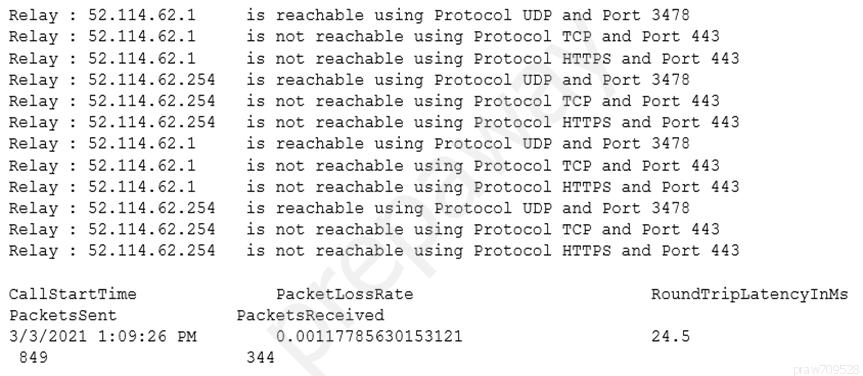 Question
HOTSPOT -
Question
HOTSPOT -
You need to set up the calling environment for the sales and support departments.
Which setup paths should you use? To answer, select the appropriate options in the answer area.
NOTE: Each correct selection is worth one point.
Hot Area: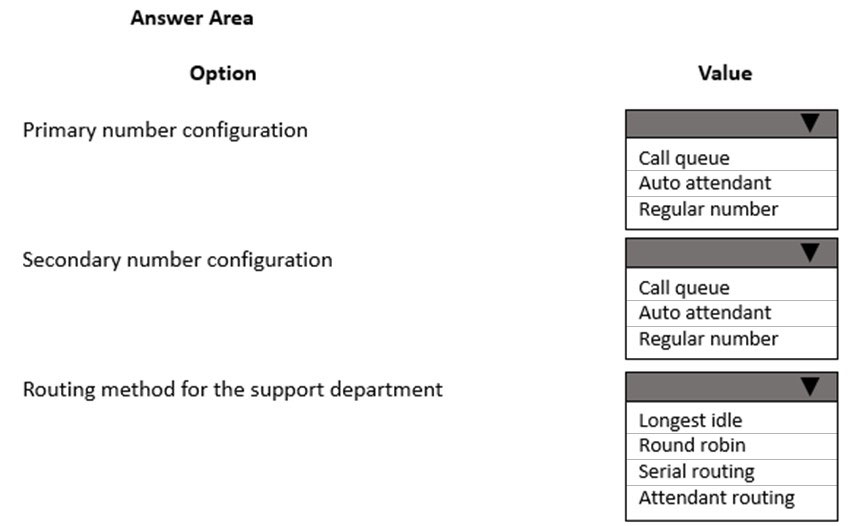
Answer:
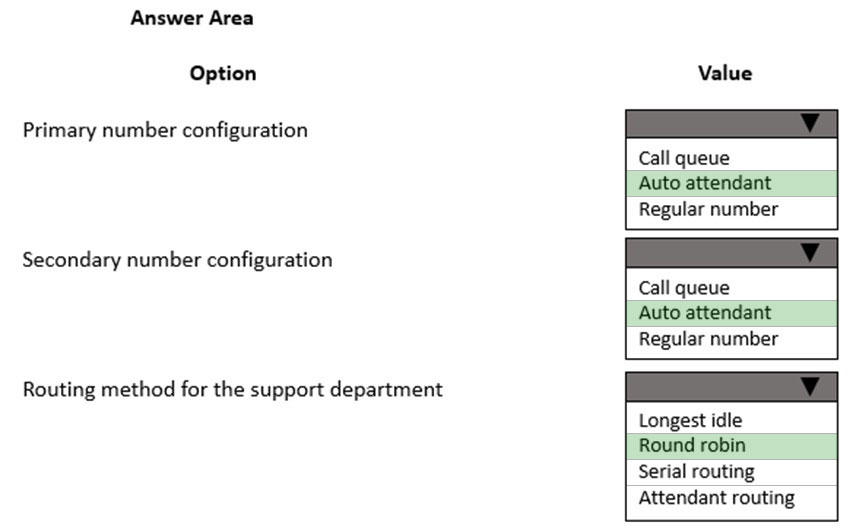
Reference:
https://docs.microsoft.com/en-us/microsoftteams/plan-auto-attendant-call-queue https://docs.microsoft.com/en-us/microsoftteams/create-a-phone-system-call-queue
Introductory Info
Case study -
This is a case study. Case studies are not timed separately. You can use as much exam time as you would like to complete each case. However, there may be additional case studies and sections on this exam. You must manage your time to ensure that you are able to complete all questions included on this exam in the time provided.
To answer the questions included in a case study, you will need to reference information that is provided in the case study. Case studies might contain exhibits and other resources that provide more information about the scenario that is described in the case study. Each question is independent of the other questions in this case study.
At the end of this case study, a review screen will appear. This screen allows you to review your answers and to make changes before you move to the next section of the exam. After you begin a new section, you cannot return to this section.
To start the case study -
To display the first question in this case study, click the Next button. Use the buttons in the left pane to explore the content of the case study before you answer the questions. Clicking these buttons displays information such as business requirements, existing environment, and problem statements. When you are ready to answer a question, click the Question button to return to the question.
Background -
Fabrikam, Inc. Ltd. is a pharmaceutical company with offices in the USA, UK, and Australia. The company has the following departments:
IT
Sales
Human resources (HR)
Research and development (R&D)
Technical support
Legal department
You join the company as a Microsoft Teams administrator.
Current environment -
Active Directory -
The network contains an on-premises Active Directory domain. All user accounts are assigned to departmental organizational units (OUs).
Microsoft 365 -
You assign all employees a Microsoft Office 365 E3 license. Fabrikam has recently migrated from Skype for Business server to Microsoft Teams.
Network environment -
The company uses a combination of IPv4 and IPv6 addresses.
Calling -
The company plans to use a Session Border Controller (SBC) connected to Phone System Direct Routing for their telephony solution. The company registers the
SBC domain name, sip.contoso.com, in as tenant domain.
Requirements -
Emergency calling -
You must configure a tenant trusted IP list for emergency address locations.
Security -
Sales interns must not have the ability to share files in one-on-one chats. Teams and channels must meet following compliance requirements:
You must create the following groups for teams and channels: Team Owners, Team Members and Team Visitors.
The Team Visitors group is for internal UserX that does not have access to the Private channels chats, but does have access to SharePoint sites for auditing the files within the private channels.
Channels for the different departments must not inherit permissions from the parent sites. Permissions for each channel must be unique.
ProjectNextGenApp -
The R&D team has a private channel named ProjectNextGenApp. The members of the channel need to collaborate on files with an external user, but they do not want the external user to be able to read and send messages in the channel.
Legal department -
You must ensure that users in the legal department can view the files uploaded by owners within one channel or access SharePoint.
Issues -
CEO -
The company's CEO reports that they do not receive notifications for chat messages in the desktop version of Microsoft Teams.
AdministratorA -
AdministratorA is configuring Direct Routing. The administrator runs following PowerShell command to pair the SBC to the tenant or add the SBC from the Teams admin center.
The following error message displays:
Human resources manager -
The human resources manager is unable to access the files in a Private channel named StaffRecruiters. He gets an error message when they select the Files tab that the Item does not exist or no longer available.
Audit team -
Users who are part of the audit team report that they were unable to access the Files tab of a channel in the team. The following error message displays when they attempt to access files: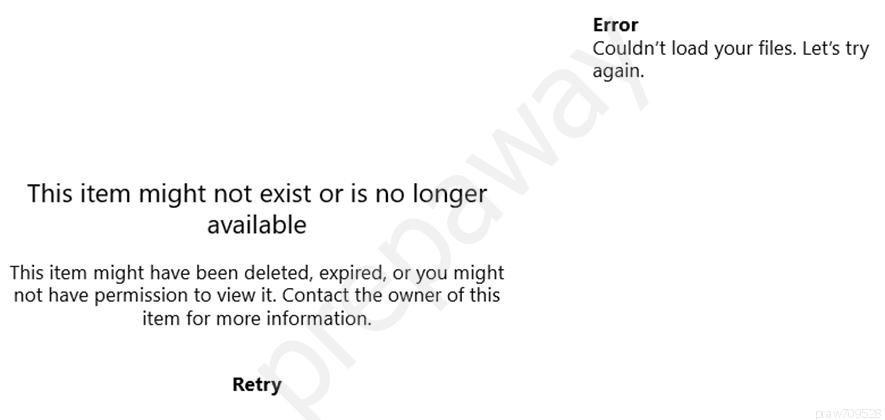
User1 -
User1 reports high CPU usage while using the Teams application and would like to know more on how Teams uses resources.
User2 -
User2 reports that automatic updates for the Teams client are not working.
User3 -
User3 reports that they are not able to download a file that was shared with them in a one-to-one chat within the Files tab. The following error message displays:
"This item might not exist or is no longer available."
User4 -
User4 reports that the following message displays when they navigate to the SharePoint Site for the private channel:
"Access denied"
User5 -
User5 has multiple groups and contacts but none of the groups or users appear in the Teams app. The Contact List Provider for User5 is listed as Unified Contact
Store (UCS).
User6 -
User6 reports that they are not able to download a file that was shared with them in a one-to-one chat within the Files tab and receives the follow error message:
"This item might not exist or is no longer available."
Emergency calling -
Users report that the Teams app does not display an emergency address in the calls section of client settings. No emergency address is listed when placing a call.
You collect Teams debug logs from a user. A representative section of the log is shown below:
Reports -
Users within the company report poor quality when they make Teams calls and dial telephone numbers. You must generate the following reports to troubleshoot the issues:
Report1: Show Public Switched Telephone Network (PSTN) calls for the last 28 days.
Report2: Compare usage and quality across users.
Question
You need to resolve the chat notification issue.
Which three actions should you perform? Each correct answer presents part of the solution.
NOTE: Each correct selection is worth one point.
Answer:
BDE
Reference:
https://support.microsoft.com/en-us/office/manage-notifications-in-teams-1cc31834-5fe5-412b-8edb-43fecc78413d https://support.microsoft.com/en-us/windows/change-notification-and-action-settings-in-windows-10-8942c744-6198-fe56-4639-34320cf9444e
Introductory Info
Case study -
This is a case study. Case studies are not timed separately. You can use as much exam time as you would like to complete each case. However, there may be additional case studies and sections on this exam. You must manage your time to ensure that you are able to complete all questions included on this exam in the time provided.
To answer the questions included in a case study, you will need to reference information that is provided in the case study. Case studies might contain exhibits and other resources that provide more information about the scenario that is described in the case study. Each question is independent of the other questions in this case study.
At the end of this case study, a review screen will appear. This screen allows you to review your answers and to make changes before you move to the next section of the exam. After you begin a new section, you cannot return to this section.
To start the case study -
To display the first question in this case study, click the Next button. Use the buttons in the left pane to explore the content of the case study before you answer the questions. Clicking these buttons displays information such as business requirements, existing environment, and problem statements. When you are ready to answer a question, click the Question button to return to the question.
Background -
Fabrikam, Inc. Ltd. is a pharmaceutical company with offices in the USA, UK, and Australia. The company has the following departments:
IT
Sales
Human resources (HR)
Research and development (R&D)
Technical support
Legal department
You join the company as a Microsoft Teams administrator.
Current environment -
Active Directory -
The network contains an on-premises Active Directory domain. All user accounts are assigned to departmental organizational units (OUs).
Microsoft 365 -
You assign all employees a Microsoft Office 365 E3 license. Fabrikam has recently migrated from Skype for Business server to Microsoft Teams.
Network environment -
The company uses a combination of IPv4 and IPv6 addresses.
Calling -
The company plans to use a Session Border Controller (SBC) connected to Phone System Direct Routing for their telephony solution. The company registers the
SBC domain name, sip.contoso.com, in as tenant domain.
Requirements -
Emergency calling -
You must configure a tenant trusted IP list for emergency address locations.
Security -
Sales interns must not have the ability to share files in one-on-one chats. Teams and channels must meet following compliance requirements:
You must create the following groups for teams and channels: Team Owners, Team Members and Team Visitors.
The Team Visitors group is for internal UserX that does not have access to the Private channels chats, but does have access to SharePoint sites for auditing the files within the private channels.
Channels for the different departments must not inherit permissions from the parent sites. Permissions for each channel must be unique.
ProjectNextGenApp -
The R&D team has a private channel named ProjectNextGenApp. The members of the channel need to collaborate on files with an external user, but they do not want the external user to be able to read and send messages in the channel.
Legal department -
You must ensure that users in the legal department can view the files uploaded by owners within one channel or access SharePoint.
Issues -
CEO -
The company's CEO reports that they do not receive notifications for chat messages in the desktop version of Microsoft Teams.
AdministratorA -
AdministratorA is configuring Direct Routing. The administrator runs following PowerShell command to pair the SBC to the tenant or add the SBC from the Teams admin center.
The following error message displays:
Human resources manager -
The human resources manager is unable to access the files in a Private channel named StaffRecruiters. He gets an error message when they select the Files tab that the Item does not exist or no longer available.
Audit team -
Users who are part of the audit team report that they were unable to access the Files tab of a channel in the team. The following error message displays when they attempt to access files:
User1 -
User1 reports high CPU usage while using the Teams application and would like to know more on how Teams uses resources.
User2 -
User2 reports that automatic updates for the Teams client are not working.
User3 -
User3 reports that they are not able to download a file that was shared with them in a one-to-one chat within the Files tab. The following error message displays:
"This item might not exist or is no longer available."
User4 -
User4 reports that the following message displays when they navigate to the SharePoint Site for the private channel:
"Access denied"
User5 -
User5 has multiple groups and contacts but none of the groups or users appear in the Teams app. The Contact List Provider for User5 is listed as Unified Contact
Store (UCS).
User6 -
User6 reports that they are not able to download a file that was shared with them in a one-to-one chat within the Files tab and receives the follow error message:
"This item might not exist or is no longer available."
Emergency calling -
Users report that the Teams app does not display an emergency address in the calls section of client settings. No emergency address is listed when placing a call.
You collect Teams debug logs from a user. A representative section of the log is shown below:
Reports -
Users within the company report poor quality when they make Teams calls and dial telephone numbers. You must generate the following reports to troubleshoot the issues:
Report1: Show Public Switched Telephone Network (PSTN) calls for the last 28 days.
Report2: Compare usage and quality across users.
Question
You need to provide the correct statements to User1.
Which two statements are correct? Each correct answer presents a complete solution.
NOTE: Each correct selection is worth one point.
Answer:
CD
Reference:
https://docs.microsoft.com/en-us/microsoftteams/teams-memory-usage-perf
Introductory Info
Case study -
This is a case study. Case studies are not timed separately. You can use as much exam time as you would like to complete each case. However, there may be additional case studies and sections on this exam. You must manage your time to ensure that you are able to complete all questions included on this exam in the time provided.
To answer the questions included in a case study, you will need to reference information that is provided in the case study. Case studies might contain exhibits and other resources that provide more information about the scenario that is described in the case study. Each question is independent of the other questions in this case study.
At the end of this case study, a review screen will appear. This screen allows you to review your answers and to make changes before you move to the next section of the exam. After you begin a new section, you cannot return to this section.
To start the case study -
To display the first question in this case study, click the Next button. Use the buttons in the left pane to explore the content of the case study before you answer the questions. Clicking these buttons displays information such as business requirements, existing environment, and problem statements. When you are ready to answer a question, click the Question button to return to the question.
Background -
Contoso, Ltd. is a telecommunications company that has offices in Bulgaria, Italy, Canada, and the United States. The company has 5,000 employees. The company has the following departments:
IT
Sales
Human resources (HR)
Research and development (R&D)
Technical support
Legal
The company does a lot of business with the following partner companies. Contoso employees are not able to communicate with these partners by using Microsoft
Teams.
Microsoft.com
PartnerCompanyLTD.com
The company currently uses Skype for Business (SfB) as a collaboration tool. The company wants to migrate to Microsoft Teams. Contoso is beginning a pilot project as part of a Microsoft Teams upgrade. You determine that some offices do not have calling plan licenses.
Current environment -
Active directory -
The network contains an on-premises Active Directory domain. All user accounts are assigned to departmental organizational units (OUs).
Network environment -
All traffic is routed through a VPN solution.
Average network bandwidth on Wi-Fi is 3.2 mbps.
Microsoft 365 -
You assign all employees a Microsoft Office 365 E5 license. You enable the following services for all users:
Microsoft Exchange Online
Microsoft SharePoint Online
Microsoft OneDrive for Business
Azure AD dynamic group membership
Azure Active Directory (Azure AD)
Microsoft Teams -
The Microsoft Teams upgrade policy is set to Islands coexistence mode.
Requirements -
Calling -
You must create auto attendants and call queue groups for the sales department and the support department. You must configure the following numbers:
Sales department employees must be able to dial international numbers. Other department employees must be prevented from dialing international numbers.
The secondary number for the sales department must always be displayed whenever a sales department employee makes an outbound call.
Calls to support team members must be distributed in such a way that each agent gets the same number of calls.
Emergency calling -
You must configure the following normalization rules for emergency calls:
Sales department users need to use 4-digit extension calling.
Support department users need to use 5-digit extension calling.
All local calls for Redmond (country code and region code is +1425) should be dialed without having to put the +1425 in front of the number.
Security -
You must implement dynamic group membership and use the department's attribute.
Users must change their password every 60 days.
You must implement a new security policy that has the following requirements:
Only guest users from the approved partner domains must be allowed to connect to collaborate by using Microsoft Teams.
Guest users must be prevented from inviting other guests.
Guest users must be prevented from making private calls.
The sales and the technical support department should be able to dial out using the corresponding number.
Guest users should only be allowed to chat from their own accounts.
Teams channels -
Teams and channels must meet the following compliance requirements:
Each team must expire 365 days after it is created.
All team content must be deleted when the team expires
An administrator must be able to restore deleted team content within 30 days.
Group names must not change once they are created.
Meetings and live events -
You identify the following requirements for meetings and live events:
All meetings facilitated by employees must be hosted on Microsoft Teams.
Guest users must be able to join live events.
Guest users must always wait in a meeting lobby.
Employees must always bypass the meeting lobby when they join meeting by using the Microsoft Teams client.
You must record all live events.
Issues -
User1 -
User1 starts an important meeting by using Microsoft Teams. The call drops unexpectedly. User1 provides you with the following log data after reproducing the issue:
User2 -
Administrators report that User2 can sign in to Teams. Most policies are assigned to User2, but you are not able to assign a phone number to User2. You run the following PowerShell command and review the output:
User3 -
User3 reports an authentication issue while signing in to Teams. You troubleshoot the issue by reviewing the Teams desktop app logs. You identify the following authentication error message:
0xCAA82EE7 The server name could not be resolved.
User4 -
User4 reports that they receive multiple email messages about missed chat conversations.
Sales team -
You create a Team named Test is used by the sales team.
All users report that an error message displays when they view the Files tab in the general channel for the team.
You view the following error in the debug logs:
2021-05-14T14:56:54.001Z Err items-view error:
singleOperationHandler.spFolderItemSet.getItems - File Not Found.
Conditional Access policy -
Users report a variety of issues accessing resources. You run the following PowerShell cmdlets:
$CA = Get-AzureADMSConditionalAccessPolicy `"Identity
$CA.ToJson()
You review the output from the cmdlets: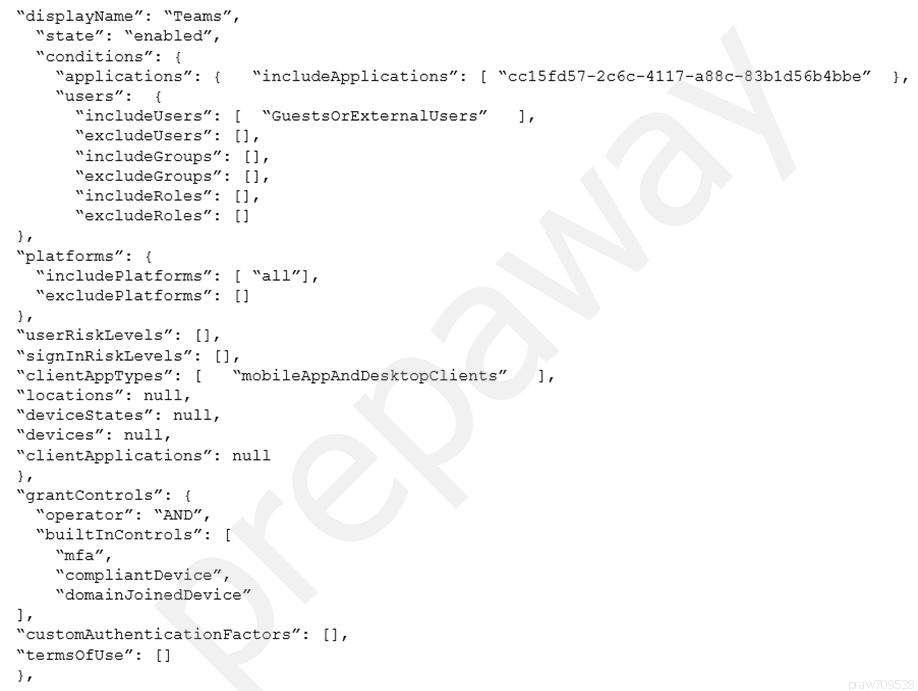
Teams performance -
After recent network changes, users report the following issues that impact all users:
Messages arrive to recipients after significant delays.
The Teams app loads slowly.
The quality of audio and video during meetings is poor.
Calls drop unexpectedly and it takes a long time to rejoin meetings.
You review the following log entries: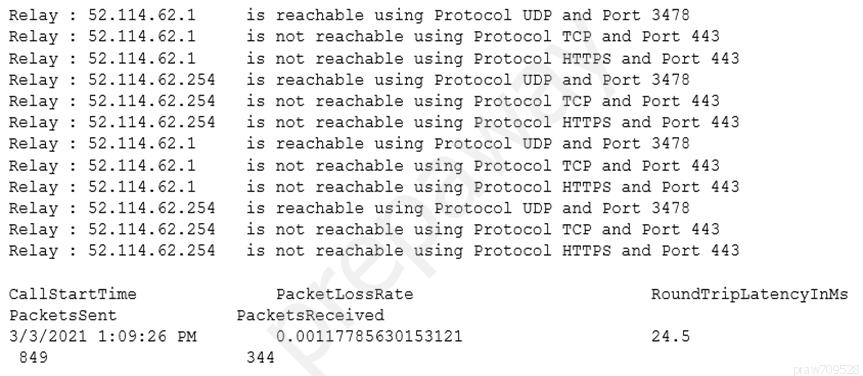 Question
You need to resolve the partner company communication issue.
Question
You need to resolve the partner company communication issue.
Which two PowerShell commands should you run? Each correct answer presents part of the solution.
NOTE: Each correct selection is worth one point.
Answer:
AC
Reference:
https://docs.microsoft.com/en-us/powershell/module/skype/set-csexternalaccesspolicy?view=skype-ps https://docs.microsoft.com/en-us/powershell/module/skype/new-csalloweddomain?view=skype-ps
Introductory Info
Case study -
This is a case study. Case studies are not timed separately. You can use as much exam time as you would like to complete each case. However, there may be additional case studies and sections on this exam. You must manage your time to ensure that you are able to complete all questions included on this exam in the time provided.
To answer the questions included in a case study, you will need to reference information that is provided in the case study. Case studies might contain exhibits and other resources that provide more information about the scenario that is described in the case study. Each question is independent of the other questions in this case study.
At the end of this case study, a review screen will appear. This screen allows you to review your answers and to make changes before you move to the next section of the exam. After you begin a new section, you cannot return to this section.
To start the case study -
To display the first question in this case study, click the Next button. Use the buttons in the left pane to explore the content of the case study before you answer the questions. Clicking these buttons displays information such as business requirements, existing environment, and problem statements. When you are ready to answer a question, click the Question button to return to the question.
Background -
Contoso, Ltd. is a telecommunications company that has offices in Bulgaria, Italy, Canada, and the United States. The company has 5,000 employees. The company has the following departments:
IT
Sales
Human resources (HR)
Research and development (R&D)
Technical support
Legal
The company does a lot of business with the following partner companies. Contoso employees are not able to communicate with these partners by using Microsoft
Teams.
Microsoft.com
PartnerCompanyLTD.com
The company currently uses Skype for Business (SfB) as a collaboration tool. The company wants to migrate to Microsoft Teams. Contoso is beginning a pilot project as part of a Microsoft Teams upgrade. You determine that some offices do not have calling plan licenses.
Current environment -
Active directory -
The network contains an on-premises Active Directory domain. All user accounts are assigned to departmental organizational units (OUs).
Network environment -
All traffic is routed through a VPN solution.
Average network bandwidth on Wi-Fi is 3.2 mbps.
Microsoft 365 -
You assign all employees a Microsoft Office 365 E5 license. You enable the following services for all users:
Microsoft Exchange Online
Microsoft SharePoint Online
Microsoft OneDrive for Business
Azure AD dynamic group membership
Azure Active Directory (Azure AD)
Microsoft Teams -
The Microsoft Teams upgrade policy is set to Islands coexistence mode.
Requirements -
Calling -
You must create auto attendants and call queue groups for the sales department and the support department. You must configure the following numbers:
Sales department employees must be able to dial international numbers. Other department employees must be prevented from dialing international numbers.
The secondary number for the sales department must always be displayed whenever a sales department employee makes an outbound call.
Calls to support team members must be distributed in such a way that each agent gets the same number of calls.
Emergency calling -
You must configure the following normalization rules for emergency calls:
Sales department users need to use 4-digit extension calling.
Support department users need to use 5-digit extension calling.
All local calls for Redmond (country code and region code is +1425) should be dialed without having to put the +1425 in front of the number.
Security -
You must implement dynamic group membership and use the department's attribute.
Users must change their password every 60 days.
You must implement a new security policy that has the following requirements:
Only guest users from the approved partner domains must be allowed to connect to collaborate by using Microsoft Teams.
Guest users must be prevented from inviting other guests.
Guest users must be prevented from making private calls.
The sales and the technical support department should be able to dial out using the corresponding number.
Guest users should only be allowed to chat from their own accounts.
Teams channels -
Teams and channels must meet the following compliance requirements:
Each team must expire 365 days after it is created.
All team content must be deleted when the team expires
An administrator must be able to restore deleted team content within 30 days.
Group names must not change once they are created.
Meetings and live events -
You identify the following requirements for meetings and live events:
All meetings facilitated by employees must be hosted on Microsoft Teams.
Guest users must be able to join live events.
Guest users must always wait in a meeting lobby.
Employees must always bypass the meeting lobby when they join meeting by using the Microsoft Teams client.
You must record all live events.
Issues -
User1 -
User1 starts an important meeting by using Microsoft Teams. The call drops unexpectedly. User1 provides you with the following log data after reproducing the issue:
User2 -
Administrators report that User2 can sign in to Teams. Most policies are assigned to User2, but you are not able to assign a phone number to User2. You run the following PowerShell command and review the output:
User3 -
User3 reports an authentication issue while signing in to Teams. You troubleshoot the issue by reviewing the Teams desktop app logs. You identify the following authentication error message:
0xCAA82EE7 The server name could not be resolved.
User4 -
User4 reports that they receive multiple email messages about missed chat conversations.
Sales team -
You create a Team named Test is used by the sales team.
All users report that an error message displays when they view the Files tab in the general channel for the team.
You view the following error in the debug logs:
2021-05-14T14:56:54.001Z Err items-view error:
singleOperationHandler.spFolderItemSet.getItems - File Not Found.
Conditional Access policy -
Users report a variety of issues accessing resources. You run the following PowerShell cmdlets:
$CA = Get-AzureADMSConditionalAccessPolicy `"Identity
$CA.ToJson()
You review the output from the cmdlets:
Teams performance -
After recent network changes, users report the following issues that impact all users:
Messages arrive to recipients after significant delays.
The Teams app loads slowly.
The quality of audio and video during meetings is poor.
Calls drop unexpectedly and it takes a long time to rejoin meetings.
You review the following log entries: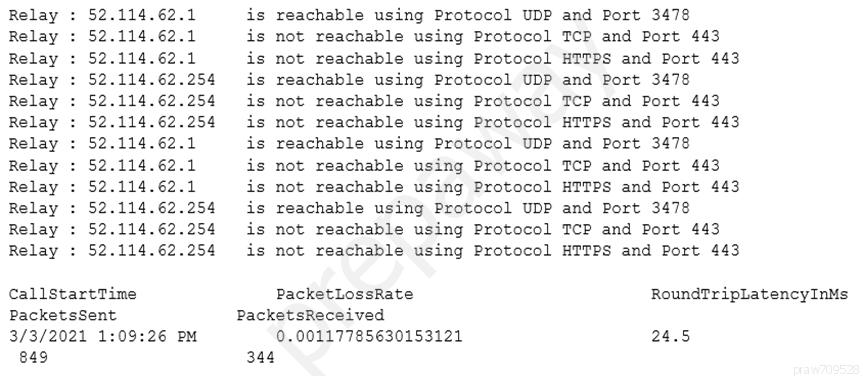 Question
You need to configure the system to meet the requirements for guest users.
Question
You need to configure the system to meet the requirements for guest users.
Which two actions should you perform? Each correct answer presents part of the solution.
NOTE: Each correct selection is worth one point.
Answer:
AC
Reference:
https://docs.microsoft.com/en-us/microsoftteams/teams-calling-policy
Introductory Info
Case study -
This is a case study. Case studies are not timed separately. You can use as much exam time as you would like to complete each case. However, there may be additional case studies and sections on this exam. You must manage your time to ensure that you are able to complete all questions included on this exam in the time provided.
To answer the questions included in a case study, you will need to reference information that is provided in the case study. Case studies might contain exhibits and other resources that provide more information about the scenario that is described in the case study. Each question is independent of the other questions in this case study.
At the end of this case study, a review screen will appear. This screen allows you to review your answers and to make changes before you move to the next section of the exam. After you begin a new section, you cannot return to this section.
To start the case study -
To display the first question in this case study, click the Next button. Use the buttons in the left pane to explore the content of the case study before you answer the questions. Clicking these buttons displays information such as business requirements, existing environment, and problem statements. When you are ready to answer a question, click the Question button to return to the question.
Background -
Contoso, Ltd. is a telecommunications company that has offices in Bulgaria, Italy, Canada, and the United States. The company has 5,000 employees. The company has the following departments:
IT
Sales
Human resources (HR)
Research and development (R&D)
Technical support
Legal
The company does a lot of business with the following partner companies. Contoso employees are not able to communicate with these partners by using Microsoft
Teams.
Microsoft.com
PartnerCompanyLTD.com
The company currently uses Skype for Business (SfB) as a collaboration tool. The company wants to migrate to Microsoft Teams. Contoso is beginning a pilot project as part of a Microsoft Teams upgrade. You determine that some offices do not have calling plan licenses.
Current environment -
Active directory -
The network contains an on-premises Active Directory domain. All user accounts are assigned to departmental organizational units (OUs).
Network environment -
All traffic is routed through a VPN solution.
Average network bandwidth on Wi-Fi is 3.2 mbps.
Microsoft 365 -
You assign all employees a Microsoft Office 365 E5 license. You enable the following services for all users:
Microsoft Exchange Online
Microsoft SharePoint Online
Microsoft OneDrive for Business
Azure AD dynamic group membership
Azure Active Directory (Azure AD)
Microsoft Teams -
The Microsoft Teams upgrade policy is set to Islands coexistence mode.
Requirements -
Calling -
You must create auto attendants and call queue groups for the sales department and the support department. You must configure the following numbers:
Sales department employees must be able to dial international numbers. Other department employees must be prevented from dialing international numbers.
The secondary number for the sales department must always be displayed whenever a sales department employee makes an outbound call.
Calls to support team members must be distributed in such a way that each agent gets the same number of calls.
Emergency calling -
You must configure the following normalization rules for emergency calls:
Sales department users need to use 4-digit extension calling.
Support department users need to use 5-digit extension calling.
All local calls for Redmond (country code and region code is +1425) should be dialed without having to put the +1425 in front of the number.
Security -
You must implement dynamic group membership and use the department's attribute.
Users must change their password every 60 days.
You must implement a new security policy that has the following requirements:
Only guest users from the approved partner domains must be allowed to connect to collaborate by using Microsoft Teams.
Guest users must be prevented from inviting other guests.
Guest users must be prevented from making private calls.
The sales and the technical support department should be able to dial out using the corresponding number.
Guest users should only be allowed to chat from their own accounts.
Teams channels -
Teams and channels must meet the following compliance requirements:
Each team must expire 365 days after it is created.
All team content must be deleted when the team expires
An administrator must be able to restore deleted team content within 30 days.
Group names must not change once they are created.
Meetings and live events -
You identify the following requirements for meetings and live events:
All meetings facilitated by employees must be hosted on Microsoft Teams.
Guest users must be able to join live events.
Guest users must always wait in a meeting lobby.
Employees must always bypass the meeting lobby when they join meeting by using the Microsoft Teams client.
You must record all live events.
Issues -
User1 -
User1 starts an important meeting by using Microsoft Teams. The call drops unexpectedly. User1 provides you with the following log data after reproducing the issue:
User2 -
Administrators report that User2 can sign in to Teams. Most policies are assigned to User2, but you are not able to assign a phone number to User2. You run the following PowerShell command and review the output:
User3 -
User3 reports an authentication issue while signing in to Teams. You troubleshoot the issue by reviewing the Teams desktop app logs. You identify the following authentication error message:
0xCAA82EE7 The server name could not be resolved.
User4 -
User4 reports that they receive multiple email messages about missed chat conversations.
Sales team -
You create a Team named Test is used by the sales team.
All users report that an error message displays when they view the Files tab in the general channel for the team.
You view the following error in the debug logs:
2021-05-14T14:56:54.001Z Err items-view error:
singleOperationHandler.spFolderItemSet.getItems - File Not Found.
Conditional Access policy -
Users report a variety of issues accessing resources. You run the following PowerShell cmdlets:
$CA = Get-AzureADMSConditionalAccessPolicy `"Identity
$CA.ToJson()
You review the output from the cmdlets:
Teams performance -
After recent network changes, users report the following issues that impact all users:
Messages arrive to recipients after significant delays.
The Teams app loads slowly.
The quality of audio and video during meetings is poor.
Calls drop unexpectedly and it takes a long time to rejoin meetings.
You review the following log entries: Question
You need to resolve the issue reported by User3.
Question
You need to resolve the issue reported by User3.
What should you do?
Answer:
B
Reference:
https://support.microsoft.com/en-us/office/why-am-i-having-trouble-signing-in-to-microsoft-teams-a02f683b-61a3-4008-9447-ee60c5593b0f
Introductory Info
Case study -
This is a case study. Case studies are not timed separately. You can use as much exam time as you would like to complete each case. However, there may be additional case studies and sections on this exam. You must manage your time to ensure that you are able to complete all questions included on this exam in the time provided.
To answer the questions included in a case study, you will need to reference information that is provided in the case study. Case studies might contain exhibits and other resources that provide more information about the scenario that is described in the case study. Each question is independent of the other questions in this case study.
At the end of this case study, a review screen will appear. This screen allows you to review your answers and to make changes before you move to the next section of the exam. After you begin a new section, you cannot return to this section.
To start the case study -
To display the first question in this case study, click the Next button. Use the buttons in the left pane to explore the content of the case study before you answer the questions. Clicking these buttons displays information such as business requirements, existing environment, and problem statements. When you are ready to answer a question, click the Question button to return to the question.
Background -
Contoso, Ltd. is a telecommunications company that has offices in Bulgaria, Italy, Canada, and the United States. The company has 5,000 employees. The company has the following departments:
IT
Sales
Human resources (HR)
Research and development (R&D)
Technical support
Legal
The company does a lot of business with the following partner companies. Contoso employees are not able to communicate with these partners by using Microsoft
Teams.
Microsoft.com
PartnerCompanyLTD.com
The company currently uses Skype for Business (SfB) as a collaboration tool. The company wants to migrate to Microsoft Teams. Contoso is beginning a pilot project as part of a Microsoft Teams upgrade. You determine that some offices do not have calling plan licenses.
Current environment -
Active directory -
The network contains an on-premises Active Directory domain. All user accounts are assigned to departmental organizational units (OUs).
Network environment -
All traffic is routed through a VPN solution.
Average network bandwidth on Wi-Fi is 3.2 mbps.
Microsoft 365 -
You assign all employees a Microsoft Office 365 E5 license. You enable the following services for all users:
Microsoft Exchange Online
Microsoft SharePoint Online
Microsoft OneDrive for Business
Azure AD dynamic group membership
Azure Active Directory (Azure AD)
Microsoft Teams -
The Microsoft Teams upgrade policy is set to Islands coexistence mode.
Requirements -
Calling -
You must create auto attendants and call queue groups for the sales department and the support department. You must configure the following numbers:
Sales department employees must be able to dial international numbers. Other department employees must be prevented from dialing international numbers.
The secondary number for the sales department must always be displayed whenever a sales department employee makes an outbound call.
Calls to support team members must be distributed in such a way that each agent gets the same number of calls.
Emergency calling -
You must configure the following normalization rules for emergency calls:
Sales department users need to use 4-digit extension calling.
Support department users need to use 5-digit extension calling.
All local calls for Redmond (country code and region code is +1425) should be dialed without having to put the +1425 in front of the number.
Security -
You must implement dynamic group membership and use the department's attribute.
Users must change their password every 60 days.
You must implement a new security policy that has the following requirements:
Only guest users from the approved partner domains must be allowed to connect to collaborate by using Microsoft Teams.
Guest users must be prevented from inviting other guests.
Guest users must be prevented from making private calls.
The sales and the technical support department should be able to dial out using the corresponding number.
Guest users should only be allowed to chat from their own accounts.
Teams channels -
Teams and channels must meet the following compliance requirements:
Each team must expire 365 days after it is created.
All team content must be deleted when the team expires
An administrator must be able to restore deleted team content within 30 days.
Group names must not change once they are created.
Meetings and live events -
You identify the following requirements for meetings and live events:
All meetings facilitated by employees must be hosted on Microsoft Teams.
Guest users must be able to join live events.
Guest users must always wait in a meeting lobby.
Employees must always bypass the meeting lobby when they join meeting by using the Microsoft Teams client.
You must record all live events.
Issues -
User1 -
User1 starts an important meeting by using Microsoft Teams. The call drops unexpectedly. User1 provides you with the following log data after reproducing the issue:
User2 -
Administrators report that User2 can sign in to Teams. Most policies are assigned to User2, but you are not able to assign a phone number to User2. You run the following PowerShell command and review the output:
User3 -
User3 reports an authentication issue while signing in to Teams. You troubleshoot the issue by reviewing the Teams desktop app logs. You identify the following authentication error message:
0xCAA82EE7 The server name could not be resolved.
User4 -
User4 reports that they receive multiple email messages about missed chat conversations.
Sales team -
You create a Team named Test is used by the sales team.
All users report that an error message displays when they view the Files tab in the general channel for the team.
You view the following error in the debug logs:
2021-05-14T14:56:54.001Z Err items-view error:
singleOperationHandler.spFolderItemSet.getItems - File Not Found.
Conditional Access policy -
Users report a variety of issues accessing resources. You run the following PowerShell cmdlets:
$CA = Get-AzureADMSConditionalAccessPolicy `"Identity
$CA.ToJson()
You review the output from the cmdlets:
Teams performance -
After recent network changes, users report the following issues that impact all users:
Messages arrive to recipients after significant delays.
The Teams app loads slowly.
The quality of audio and video during meetings is poor.
Calls drop unexpectedly and it takes a long time to rejoin meetings.
You review the following log entries: Question
You need to configure team settings specific to all departments' needs.
Question
You need to configure team settings specific to all departments' needs.
What should you do?
Answer:
A
Reference:
https://docs.microsoft.com/en-us/azure/active-directory/enterprise-users/groups-lifecycle